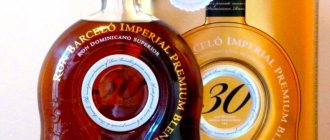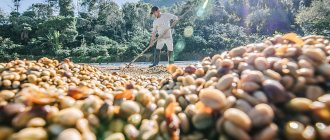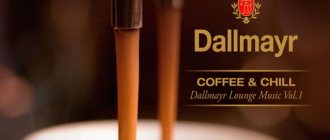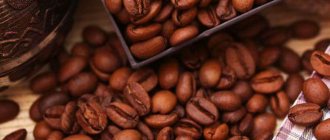Acidity is one of the most important parameters of coffee taste. Professionals distinguish several shades and find their charm in sourness, but many people at first find it unusual. So, let’s figure out why coffee is sour, what shades there are, how to choose more or less sour coffee or correct its taste according to your preferences.
Composition of coffee beans
The fruits of the coffee tree are usually called beans, but in biology they are berries. In England they are even called cherries. And like all berries, coffee has a rich composition and rich taste. The latter is imparted to the drink by chemical compounds, of which there are more than 100 in coffee fruits.
The main substances affecting the characteristics of the drink:
- Alkaloids (caffeine and trigonelline) - act as an energy drink; when heated and destroyed, they contribute to the formation of vitamin B3. Their presence in the composition helps the fried fruits have a pleasant smell.
- Carbohydrates (fructose, sucrose, lactose, glucose) – give brewed coffee a sweet taste.
- Organic fruit acids (malic, citric, tartaric, etc.) – make the drink taste sour.
- Organic chlorogenic acid – contributes to the bitter taste.
- Tannins – add astringency and bitterness.
The amount of substances in coffee beans varies depending on the variety and location of the tree.
Types of acids
The fruit contains several varieties of such compounds. Each affects the characteristics of the product.
The taste of sourness in brewed coffee varies depending on which substance is more present in the raw material. Wine notes indicate the superiority of tartaric acid, citrus notes – citric acid, berry notes – malic acid, etc.
The presence of acetic acid in the drink is a consequence of excessive fermentation of the collected fruits. Its taste in coffee signals that the product is of low quality and is not worth buying.
Chlorogenic acid has a neutral taste, but during prolonged roasting of fruits it decomposes into phenylindanes. And now they make the drink bitter. The darker the roast, the richer the flavor.
How to choose a non-sour variety?
Not everyone likes the sour taste, so it’s a good idea to learn how to choose a product that is not sour. A variety of coffee beans called Robusta will come to the rescue. There are no acids in it, but sometimes a strong bitterness is felt.
Nevertheless, Arabica is considered a higher quality raw material. Therefore, coffee lovers cannot ignore it. Experts advise paying attention to the following varieties:
- Santos. This variety is grown in the plains of Brazil and has a mild flavor.
- Malabar Monsoon. This type of raw material is imported from India. The dry method of processing the crop helps eliminate excess acidity of the product.
- Nepali. This drink is guaranteed to be free of any sour notes.
What affects the sour taste of coffee?
Acidity is a natural characteristic of fruits. Its level is influenced by many factors.
Type of coffee
For the needs of the food industry, 4 types of crops are used:
- Arabica;
- robusta;
- excelsa;
- liberica.
Excelsa is considered the most expensive. It has a mild taste and aroma that is more reminiscent of fruit than coffee. The fruits of the crop include a small amount of caffeine. If you use raw materials in their pure form, the drink will have a nutty or sour taste.
Recently, varieties based on coffee species growing wild in Ethiopia have begun to appear on the market. They have the best qualities.
Arabica is the most popular type of crop. This is due to its good taste and ease of cultivation. Today the share of this raw material on the world market reaches 70%. The variety appeared as a result of crossing two others - robusta and eugenioides.
Robusta is less in demand, but also has an attractive taste. Its share of the global market is just under 30%.
Other types are rare, their sales volumes do not exceed 2% of the total amount of coffee.
Arabica and Robusta differ greatly in taste. The first contains a large amount of sugars and lipids, due to which the level of acid in its composition is high.
In Robusta, the balance of substances is shifted towards chlorogenic compounds and caffeine. There are few sugars and lipids. This contributes to the presence of bitterness and astringency in the finished product.
Liberica is the third most common type after Arabica and Robusta. Coffee based on it has a bitter and pungent taste, so the raw material is rarely used in its pure form. The best use is to add it to coffee mixtures.
Growing height
The taste of beans of the same variety varies depending on the place of cultivation. An important factor is the height of the plantation.
For example, fruits grown at altitudes between 600 and 1200 m produce notes of grass or earth when brewed. The taste of coffee improves when changing from dry to wet processing.
If the berries are picked at an altitude of 1200 to 1800 m, the coffee will have a chocolate-vanilla, nutty or citrus flavor.
Fruits obtained at an altitude of more than 1800 m have the highest taste qualities. Drinks prepared on their basis are distinguished by shades of berries, fruits, flowers or wine sourness. Such raw materials are expensive.
Processing method
Today, most coffee beans are processed in two main ways: dry (natural) and wet (washed). A third option is also known - hani (half-washed), but it is not widely used.
With the dry method, the berries of the crop are scattered under the sun and dried naturally for 2 to 4 weeks. In this case, the grains are not cleared of pulp. During the drying process, they absorb all the flavor components of the berries: they become sweeter, more aromatic, and acquire fruity or citrus notes.
Dry drying is also divided into several types.
During processing use:
- special bedding;
- concrete bases;
- land.
Each method affects the taste of coffee. For example, when placed on soil, raw materials acquire pronounced earthy notes.
The berries scattered on the surfaces undergo a fermentation process, i.e. are ripening. Chemical reactions enhance the taste of coffee and make it richer. But the main thing here is to stop drying in time so that the coffee does not turn sour. Acetic acid appears in fermented raw materials, which gives the brewed product an unpleasant taste.
Wet processing is a technologically more complex process that must be started within 24 hours of harvesting the fruit. First of all, the berries are depulped - removed from the pulp, then placed in a yeast solution to clean the grains from the sticky substance covering them and fermentation. The process lasts from 6 hours to 3 days depending on the variety, maturity and number of grains. At the last stage, the raw materials are washed and dried.
Coffee that has been processed with washing takes on an acidic aroma. It is almost not sweet, but has a balanced and delicate taste, including notes of both fruit and dark chocolate.
Honey processing combines 2 main methods. The collected raw materials are first depulped and then dried naturally. When there is a lot of pulp left on the core, the product turns black. If the grains are completely cleaned, they will be light. Depending on this, the taste of the final product changes. The more pulp remains on the grain, the more fruity notes it acquires. The purified raw materials have a creamy taste with a slight sourness.
Roasting degree
This is an important factor influencing the characteristics of the drink.
Roasting is divided into 3 types:
- light;
- average;
- dark.
The first involves processing at a temperature of +180…+205°C. During the process, the raw material increases in size and cracks. This is called the first crack (there can be two of them). Beans roasted in this way have a strong coffee smell and bright sourness.
Medium roasting occurs at a temperature of +210...+230°C and gives the raw material a chocolate color. The grains are considered ready for some time after the first crack. The drink made from them has a sour-bitter taste and a coffee-like, smoky smell.
Dark roasting gives the raw material a dark chocolate color and a bitter taste. The processing temperature ranges from +240…+250°C. Roasting stops after the second crack.
How to make regular espresso taste better
If a person does not like the taste of traditional espresso, you can add alcohol to it:
Espresso con panna is also popular:
- First, the traditional version of the drink is brewed. It is poured into a separate cup.
- Place a “cap” of whipped cream on top of the thick foam. If desired, you can additionally add a little chocolate chips to the Con Panna espresso.
Liqueur, brandy or sambuca are added to espresso corretto. The inhabitants of the northern part of Italy are accustomed to drinking corretto with grappa in the morning.
Grappa is a type of brandy. The strength of the alcoholic drink is approximately 40-50%. It is made from the remains of grapes preserved after the end of the wine season.
Fans of sour espresso can treat themselves to Romano, which has a distinct lemon flavor. Espresso Romano can be prepared at home. To do this you will need the following ingredients: • 7 grams of ground coffee; • 35 ml water; • lemon zest or lemon slice; • 5 ml lemon juice.
First, espresso is brewed in a coffee machine. You can simply pour 7 grams of coffee powder into a pot, pour 35 ml of water and put the dish on the fire. As the coffee begins to boil, the Turk is removed from the stove. The espresso is cooled and brought to a boil again. After the Romano has cooled, add lemon juice. The finished espresso-romano is poured into a previously heated demitasse cup. Before serving, it is decorated with lemon zest or a slice of lemon.
In conclusion, it is recommended to note once again that acidity in almost everything depends on the type of coffee. Robusta has a milder taste. The taste of natural Arabica is quite sour.
Types of coffee. Varieties. Roasting. Caffeine..
Start over. So, with all the abundance of coffee trees, there are only 3 food species:
Arabica is the most whimsical, difficult to care for and produces a measured harvest, but at the same time the most valuable species, Arabica varieties that grow from 700m above sea level are especially valued; such coffee, according to the definition of the International Coffee Association, is Specialty according to our guest - “Premium” Robusta is not whimsical, disease-resistant, larger grains, more porous, simply characterized by an excess of caffeine and very high acidity. It is for this reason that Robusta is now rarely used on its own. But when combined with Arabica, the result is an impeccable espresso blend. Liberica - this type is used only (!) for honey purposes.
So there are only 3 types of coffee, but there can be a huge number of types.
Arabica in detail. Arabica can be cheap, which grows like Robusta, practically anywhere, or it can be, as we already know, of the “Premium” class. And now in more detail why this happens. The best Arabica begins to grow from 700m above sea level, it has super-hard grain. This is achieved by distinguishing between day and night temperatures. In the homeland of coffee, Kenya, Arabica grows at an altitude of at least 1900m above sea level! In Ethiopia also from 1900-2500. That’s why coffee cherries (that’s what coffee berries are called) are already sooo hardened from the very beginning.
We found out at what altitude the best coffee grows, but we must not forget that there are very few places where coffee trees produce two harvests a year, in most cases one, while 9(!) months pass from flowering to ripening, Can you imagine?! Now let’s talk about how it is collected and processed (by the way, this greatly influences its final cost). Premium class Arabica beans are collected only by picking (i.e. by hand) the most ripe and healthy coffee cherries, after which wet or dry processing is done. During dried processing, the grain is placed in peeling and shelling machines to remove the shell from it. With this method, the grains can be scratched and chipped, which significantly reduces its price. The wet method is more expensive, especially in the highlands, and takes longer. With it, the grain is first soaked, and then placed in a special peeling machine, where, together with water, all excess is washed off from it. After which the grains are scattered under tents for drying and every 3-5 hours they are rustled with special rakes.
Recommendation No. 1 It is better to take coffee in beans, because... the beans can tell us a lot right away: they must be the same size, color (except for the consistency of Viennese, French or Italian roasting, there may be a slight difference in color), the freshest coffee beans - they are oily, fragrant and most importantly without chips!
About varieties. We know that there can be a huge number of species, because... Coffee trees grow virtually all over the world. For convenience and simplicity, many companies name varieties by country of origin. Without further ado, I will characterize the species as they were characterized by experts at one time for our company.
Africa: Ethiopia - coffee, with its gentle scent of a flower bouquet, confirms the legend about the birthplace of coffee.
Kenya - coffee grown on volcanic soils with high iron content. The royal taste of this coffee with a pronounced citrus color is for the most discerning.
South and Central America Colombia is a coffee that has a rich, rich flavor aroma with the color of prunes coupled with a special sourness.
Costa Rica - the appropriate strength and richness of the drink with a strong strong taste, a persistent aroma and rich flavor colors.
Brazil has a balanced, soft taste with a slight bitterness and a good aroma.
Guatemala – the astringency and richness of this coffee, and the faint color of the smoke reflects its growth on volcanic soils.
Nicaragua is a coffee with a finely balanced flavor and a pleasant aftertaste.
Honduras - has a pronounced smell. This coffee, with the corresponding richness of the drink, is widely used to make coffee consistency.
Nicaragua Maragogipe - has the largest grains and extraordinary taste.
Indonesia Sumatra - coffee from the exotic island of Sumatra, has an appropriate and rich taste and aroma, with a light spice color
Java – coffee has a special rich taste, low acidity (not to be confused with acid in taste)
Sulawesi is a drink for lovers of a thick and catchy taste; the smell contains floral tones and a slight sourness.
Flavored coffee (well, that's right, indulge yourself, I don't like flavored coffee myself) Bavarian chocolate - coffee for those with a sweet tooth Irish cream - with the famous taste of Baileys liqueur. Amaretto is the familiar taste of almonds. French Vanilla – the sweet smell and taste of vanilla. Hawaiian Nut – Hawaiian and Brazil Nut scent. Hazelnut – coffee with the color of a nut in the taste. Chocolate almonds – a delicate nutty-chocolate taste. Reddish orange is the most exotic coffee
Espresso consistency Professional espresso is an impeccable espresso - a mixture of the best types of high-quality Arabica (80%) and Robusta (20%), creating a perfectly balanced drink with stable coffee foam. Italian espresso is a traditional combination of Arabica (90%) and Robusta (10%), and special roasting gives this drink a rich smell and taste, thick with a catchy bitterness, a persistent aftertaste reminiscent of sunny Italy. Espresso Jakarta! – a mixture of the best types of Arabica (85%) and Robusta (15%) from various countries of growth. With a slight bitterness and a persistent aftertaste. Espresso "Chaikoffsky" - universal espresso blend
Decaf - decaffeinated coffee
The rarest varieties of AustraliaSkybury - exotic coffee from the very edge of the world.
Yemen Matari is the best coffee, with an extraordinary, rich taste, a light chocolate color – its well-known aftertaste. It is often called “Coffee of the Lords”, as it is prestigious and rare.
Galapagos is a rare and unusual variety of coffee of very high quality, soft. Coffee is made in limited quantities on the San Cristobal Peninsula.
Ecuador Vilcabamba – perfectly balanced, with an amazing aroma, unusually soft.
Monsund Malabar (India) – the best quality monsoon coffee. Connoisseurs consider this type of coffee to be a drink with a unique taste.
Jamaica Blue Mountain is one of the finest, rarest and most valuable species growing in the world. "Royal Coffee"
Accumulate Luwak - coffee for real gourmets, one of the most expensive exotic varieties. The soft, refined taste of this coffee gives the drink a distinct feature and uniqueness. "Coffee for aristocrats"
Varieties with sourness (I give them in order from the most sour to almost neutral) Kenya Sulawesi Costa Rica Colombia Nicaragua Guatemala
In fact, all other varieties, except Java, Sumatra, Jamaica, and Accumulate Luwak, have a weak or pronounced bitterness. Brazil, like Nicaragua, can be classified as neutral varieties; flavored coffee is created on their basis, as well as many espresso blends.
More by variety: Vienna roast - gives a slight bitterness, this consistency of Arabica contains beans that are mainly Viennese roasted. French roast - the mixture has a bitter and creamy taste. Italian roast - the mixture has the most pronounced bitterness. The most rich and dense drink comes out. It is very suitable even for holder-type espresso coffee makers (i.e. with a coffee cup).
Types of roasting: https://www.perfect-coffee.ru/rules.php?l=1&part=1&art=4 I would like to add that not only the taste of coffee, but also the caffeine content in the bean depends on roasting. The stronger the roast, the less caffeine is contained in the beans.
What is caffeine and what does it do? CAFFEINE, a psychoactive stimulant with a bitter taste, without aroma. The effects of caffeine appear very quickly, within a couple of minutes after consumption. By influencing the central nervous system (brain and spinal cord), caffeine increases breathing, increases the frequency and strength of heart contractions, speeds up metabolism, and thereby makes you feel alert, relieves lethargy and drowsiness. Caffeine also has a diuretic effect and causes constriction of blood vessels, which determines its ability to relieve migraines caused by dilation of blood vessels in the head. In addition, it increases muscle tone and improves coordination of movements. In large doses, such as the amount contained in 4 cups of coffee drunk over a short period of time, caffeine causes anxiety, insomnia, irritability and migraines. People who frequently drink more than 5 cups of coffee a day become addicted to it, and when they stop drinking it, they may experience withdrawal symptoms: irritability, dizziness, migraines and weakness. Caffeine is destroyed in the body and eliminated within a few hours, so its direct effect is short-lived. However, although this has not yet been fully confirmed, consumption of caffeine in large doses over a long period of time can cause coronary heart disease, high blood pressure and certain congenital defects in offspring.
Caffeine is found in many widely used drinks. An ordinary cup of coffee contains about 100 mg of caffeine (a cup of decaffeinated coffee contains less than 5 mg); in a glass of tea or cola – about 50 mg; in a cup of cocoa – about 10 mg.
Caffeine is an alkaloid with the formula C8H10N4O2; its chemical name is 1,3,7-trimethylxanthine. In the industry, it is obtained by 3 methods: isolation from roasted coffee beans, which contain 0.75–1.5% caffeine; extraction from tea dust, i.e. ground tea leaves containing 1.5–3.5% caffeine; extracted from kola nuts containing about 2% caffeine. In addition, it can be obtained chemically from uric acid or by methylation of theobromine.
Caffeine increases the effect of aspirin and other analgesics and is often used together with them in over-the-counter pharmaceuticals.
In fact, caffeine is not so terrible, but on the contrary, it is beneficial for the human body if we follow the GOLDEN RULE: excess is harmful in everything!:)))
Sour and non-sour coffee varieties.
Why else can coffee sour?
The taste of a drink does not always depend on the properties of the raw material. There are other reasons for changes in characteristics.
Coffee machine malfunctions
Equipment for brewing coffee is designed taking into account popular recipes. For example, for espresso you will need to take one amount of raw materials and water, for a latte or Americano - another. A damaged coffee machine can confuse recipes. A product with a small amount of coffee and a large volume of water will taste sour.
Mold
Fungus in the coffee machine does not affect the acidity level of the prepared drink, but can give it an unpleasant musty smell.
Overdue
Raw materials that are not used within the expiration date should not be thrown away. It will lose a little of its aroma and taste, but will remain safe for health. At the same time, the acid level in the product will not increase. Only Robusta requires attention. If it has an uncharacteristic sour taste, the grains have gone bad.
Storage conditions
It is not recommended to purchase ground coffee for long-term storage. It is advisable to use it within 2 weeks from the moment of grinding. Coffee beans can be kept sealed in the refrigerator. Other storage may negatively affect the taste of the drink. The liquid will take on a sour aroma.
Cooking errors
Failure to follow the recipe or increasing the amount of water when brewing coffee can lead to the appearance of acid in it. In addition, the less a product is cooked, the higher its acidity level.
We repair at Remontano
For professional service and repair, we suggest contacting. Over more than ten years of operation of the company, our employees have repaired more than 25 thousand coffee machines. We know not only the theory of repair, but also have excellent practice.
The quality of the repair is confirmed by an official guarantee.
For replacement we use only original spare parts. This increases the service life of the equipment after repair.
Equipment restoration is carried out by a technician at the client’s home or office at a pre-agreed time.
To call a specialist, you can order a call back on the website or call by phone.
Coffee varieties with and without sourness
Depending on the acidity level, grains are divided into 3 types:
- too sour:
- moderately sour;
- non-acidic.
The first include the following varieties: Ethiopia Yorgachif, Harar and Sidamo, Kenya AA, Nicaragua, Costa Rica, Mexico, Rwanda, Burundi.
Supremo, Guatemala, Excelso, India Plantation, Ethiopia Jimma and almost all Maragojipas are considered moderately acidic.
If preference is given to other notes, it is better to buy varieties of Nicaragua Maragogip, Kopi Luwak, Brazil Santos, Peru, Malabar, Cuba, Honduras and any mixtures with robusta.
Natural sourness
Coffee varieties
Coffee berries contain three dozen acids. Professional coffee lovers divide them into three groups:
- floral acid - grapes;
- citrus – orange, lemon, berries;
- acid of nuts and cocoa.
High-quality Arabica, which grows in India, Brazil, and Colombia, is considered sour.
Sour Arabica varieties: “Burundi”, “Rwanda”, “Sidamo”, “Ethiopia Yorgachef”. Types with less pronounced sourness: “Ethiopia Jimma”, “Guatemala”, “Supremo”, “Excelso”.
These varieties make classic cappuccino or espresso.
Peculiarities
The taste of coffee depends on the altitude at which the plantation is located. Sour coffee berries grow in the mountains, and bitter coffee berries grow in the lowlands.
This feature depends on the oxygen level. On plantations up to 2000 meters above sea level it is 3 times less. The grains ripen more slowly, so they have a rich sour taste.
The sourish taste of grains is fully revealed by “washed” processing, when the pulp and gluten in the parchment shell (pachment) are removed from them.
When the coffee berries dry completely and ripen on the tree, their taste becomes sweet.
Taste in blends
Coffee producers produce several dozen blend options. In them, Arabica is mixed with Robusta in different proportions.
The acidity of the blend depends on the amount of Arabica. The more it is, the stronger the sourness will appear.
Blends with a predominance of robusta are suitable for fans of the bitter drink.
Interesting! How to brew coffee using alternative methods
At a minimum
Fans of rich, bitter espresso should take a closer look at the Robusta variety. There are no acids in it, but there is a bitterness. When choosing beans, be guided by the country of origin and the degree of roasting.
Indian Robusta cherry has a minimal sour taste. It has a deep taste and high strength.
"Maragodzhip" from the Republic of Nicaragua does not sour. It smells of spices and cocoa.
Rich, sweet espresso with faint notes of cherry is obtained from the Brazilian Mediana variety.
Arabica is considered to be of higher quality. Varieties with minimal sour taste are produced: “Brazil Santos”, “Malabar Monsoon”, Nepalese varieties: Mount Everest Kukri Specialty, Mount Everest Supreme.
German varieties have a mild taste with barely noticeable sourness: “Gorilla Bar Crema”, “Gorilla Super Bar Crema”, “Impresto Espresso Gold”.
Features of making coffee with or without sourness
Any coffee can be brewed in such a way that some of its taste qualities become more pronounced, while others fade into the background.
Cooking technology
There are several ways to hide the sourness in the finished coffee:
- Choose dark roasted raw materials.
- Drink the drink cold.
- Increase the cooking time and lower the cooking temperature.
- Purchase coarse raw materials.
These recommendations will help vary the taste of the drink from sour to bitter.
DIY repair
Modern coffee machines are quite complex devices. Manufacturers Saeco, Bosch, Vitek and others produce units in one-piece housings to protect the mechanism from unprofessional intrusion. The main goal of the user is to keep the equipment in working condition for a long time. To do this, you need to promptly clean it from spent coffee powder residues, oil deposits and scale. There are special means for these purposes. How to properly carry out decalcification and cleaning should be found in the operating instructions or on the manufacturer’s website.
Additional Information
A coffee pH value between 4.85 and 5.1 is considered average. At the same time, a product with this indicator will seem sour to most people. To reduce the richness of the taste, use the advice of experts:
- Use coarsely ground raw materials for brewing espresso.
- When cooking in a Turk, boil its contents for a minimum time.
- Keep the coffee in the French press for no more than 3-4 minutes.
- To infuse in a cup, choose the finest ground grains.
You can emphasize or neutralize the taste of coffee by drinking it with desserts. For example, espresso, Americano and ristretto have a bright taste and moderate bitterness. In order not to interrupt their aftertaste, you can serve the drink with chocolate brownie, marzipan, nuts or dark chocolate without additives. Multi-ingredient or berry desserts, on the contrary, hide the natural sourness of coffee.
Dairy options - latte, raf, cappuccino - are quite sweet. Desserts with a slight sourness are perfect for their delicate taste. A good addition would be cakes with moderately sweet berries - currants, lingonberries or raspberries, cakes with nuts or French macarons. The classic version is cheesecake with a curd base and sliced cheese. Desserts that are bitter or too sweet are not recommended to be consumed with any type of coffee.
Selection of low acidity coffee
There are two main types of low acidity drink: processed and natural.
What's the difference?
Processed low acid coffee
To create this type of product, special processing techniques are used that deliberately reduce the acid content. For example, the acidity of Brazilian coffee is reduced by slow or intermittent roasting. If you steam the beans before roasting to remove their waxy outer shell, you can achieve the same effect.
Natural low acidity coffee
This type of drink by its nature has a low concentration of acids. As a rule, this type includes coffee that is grown at low altitudes. The product from Brazil, Sumatra, Peru, Guatemala and Mexico is a natural low acidity coffee.
Processing errors
Bitter coffees sometimes give off an unpleasant acidic aftertaste. The reasons are violations of processing technology.
For example, when grains are not completely dried during preparation. Or moisture got on them at one of the processing stages.
Also, sourness appears during long fermentation - fermentation
This processing stage is comparable in importance to roasting. The grains are kept in a large vat for about 30-60 hours to remove pulp.
If the beans are left in the container longer than expected, they begin to sour.
Coffee turns sour after processing in low-quality dirty water. If you use unpurified water and dirty vats during fermentation, the taste will deteriorate.
Also, sourness appears if some of the coffee berries remain in the vat. They are processed again, then find themselves among clean grains.
In this case, a small handful of grains will ruin the entire mixture. Even mild Robusta varieties will have an aftertaste.
Types of coffee by type of coffee tree
There are several dozen species of coffee tree. According to some data - 50, according to others - almost 90. Of these, only two types of trees - Arabica and Robusta - produce grains suitable for preparing the drink we are familiar with.
Arabica or Arabian coffee
The first coffee was made from Arabica beans approximately 800-900 years ago. Arabica is native to Ethiopia, where coffee trees still grow in their natural form. Arabica was actively distributed to different countries, but acclimatization of a capricious foreigner was not an easy task. Either the climate is unsuitable, or diseases destroy entire plantations.
The trees bear fruit all year round. The grains have a strong aroma. Beans grown in valleys or on low slopes have higher caffeine content than high mountain varieties.
Robusta
Congolese coffee. It became known much later than Arabica. It has a rough, bitter taste and high caffeine content. Arabica is much more resistant to temperature fluctuations and diseases. Therefore, many modern coffee varieties are a hybrid of Arabica and Robusta. Large beans of another coffee tree, liberica, also produce coffee, but of poor quality. Liberica has no industrial significance, but some originals include these grains in mixtures.
Alkaline Products
The most effective alkaline food is lemon. The citric acid it contains is processed in the digestive tract so that its salts enter the bloodstream. Thanks to this, an alkalization reaction occurs in the body.
Active alkalizing products also include:
- greenery;
- fresh vegetables and root vegetables (except potatoes);
- rapeseed and linseed oil;
- juices from squeezed vegetables;
- melons, watermelons, zucchini and pumpkin;
- some fruits: bananas, peaches, watermelon, pineapple, grapefruit;
- figs, dates and sweet berries;
- all soy and goat milk products;
- sprouted but not boiled oats;
- bran.
Alkalinizing foods, as a rule, include magnesium and potassium salts or elements that promote their complete absorption.
The amount of such products in a person’s diet should reach 65–70% of the daily diet. In this case, the alkaline component will increase without harm to the body.
Elite varieties
High-quality coffee beans cannot be cheap - true admirers of natural drinks know this. The market has formed a rating of the best manufacturers who care about the high quality of all types of grains and packaging for their storage:
What types of elite coffee are there? The best of them are described below.
Jamaica Blue Mountain is one of the leaders among elite varieties. The beans of this variety have a blue-turquoise hue. The grains are very aromatic, giving the drink a nutty flavor. The drink is too versatile in terms of aftertaste and has good acidity. Due to the fact that the bulk of this rare coffee is purchased by Japan, it is impossible for the average coffee lover to purchase it on the market.
Kopi Luwak is considered one of the most expensive. Produced in Indonesia. A local rodent, nicknamed luwak, is directly involved in its production. It eats ripe coffee beans, and from its feces, partially digested coffee beans are extracted, which are roasted and ground to create a gourmet drink.
Old Java is the so-called aged coffee. It is obtained after 6 years of storing grains under certain conditions. The drink obtained from them has a thick consistency and unusual aroma.
Coffee varieties are a very broad concept. It is difficult to describe their exact number, but we were able to describe the majority of those on the market in this article.
Exotic coffees
For a long time, Kopi Luwak was considered the most expensive and exotic type of coffee. The luwak grains processed in the stomach of the animal got rid of natural bitterness and acquired an interesting chocolate flavor. The aromatic variety of coffee is obtained without the involvement of breeders and the latest technologies - the animal eats only the ripe, best fruits. Price – from 400 to 1000 $/kg.
There is a cheaper version of a rare variety of coffee - Monkey Coffee, obtained by Taiwanese farmers. The technology is similar to the first type, but Formosan monkeys are used to process the grains. This significantly reduced the price to $45-50/kg. The finished drink has a pronounced vanilla flavor.










